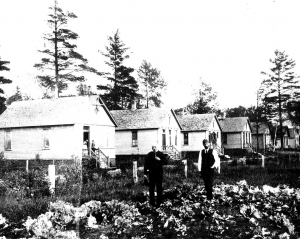
PioneersAnthony Borgo2018-03-28T18:30:31-06:00



 and Chicago railroads, built its tracks parallel to the route of the Michigan Southern to reach Chicago. The advent of the railroads and the low prices asked by the state for the swamp lands attracted shrewd investors and speculators to the region. George M. Roberts was the first to acquire land in the Whiting area, his purchases from 1851 to 1858 amounting to 471 acres.” When the Pennsylvania Railroad built a station on George Roberts’ property it was given the name Robertsdale. The railroads also brought with them immigrants, first settlers to the region, a majority of whom were of German descent. One of these immigrants was Henry Reese who worked, like several immigrants, on the construction of the railroads. An 1880 Census lists that Whiting had a population of 150 people.
and Chicago railroads, built its tracks parallel to the route of the Michigan Southern to reach Chicago. The advent of the railroads and the low prices asked by the state for the swamp lands attracted shrewd investors and speculators to the region. George M. Roberts was the first to acquire land in the Whiting area, his purchases from 1851 to 1858 amounting to 471 acres.” When the Pennsylvania Railroad built a station on George Roberts’ property it was given the name Robertsdale. The railroads also brought with them immigrants, first settlers to the region, a majority of whom were of German descent. One of these immigrants was Henry Reese who worked, like several immigrants, on the construction of the railroads. An 1880 Census lists that Whiting had a population of 150 people. According to, The Calumet Region c1959, “Some time in the 1840s, Christof Schrage brought his family from Germany to Chicago.” In 1854 Christof, a merchant, bought land in the area which would be known as Whiting and brought his family to these swampy lands. Christof’s son, Henry Schrage, joined the Union Army where he fought alongside Sherman on the “March to the Sea.” After the Civil War Henry came back to Whiting and worked on the railroads making $1.10 a day. In 1868 Henry Schrage was married to Caroline Wuestenfeldt. That same year he opened Whiting’s first store, which his wife ran, selling precious commodities to the early settlers. The store was located near the Lake Shore and Michigan Southern Station. In 1871 Whiting’s first post office was opened and Henry became the postmaster until 1892 when his son Henry, Jr. took over. Fourteen years later, Henry Schrage opened Whiting’s first financial institution, The Bank of Whiting. When Standard Oil decided to construct a refinery in Whiting, they had to buy fifty acres which was on Schrage property.
According to, The Calumet Region c1959, “Some time in the 1840s, Christof Schrage brought his family from Germany to Chicago.” In 1854 Christof, a merchant, bought land in the area which would be known as Whiting and brought his family to these swampy lands. Christof’s son, Henry Schrage, joined the Union Army where he fought alongside Sherman on the “March to the Sea.” After the Civil War Henry came back to Whiting and worked on the railroads making $1.10 a day. In 1868 Henry Schrage was married to Caroline Wuestenfeldt. That same year he opened Whiting’s first store, which his wife ran, selling precious commodities to the early settlers. The store was located near the Lake Shore and Michigan Southern Station. In 1871 Whiting’s first post office was opened and Henry became the postmaster until 1892 when his son Henry, Jr. took over. Fourteen years later, Henry Schrage opened Whiting’s first financial institution, The Bank of Whiting. When Standard Oil decided to construct a refinery in Whiting, they had to buy fifty acres which was on Schrage property.